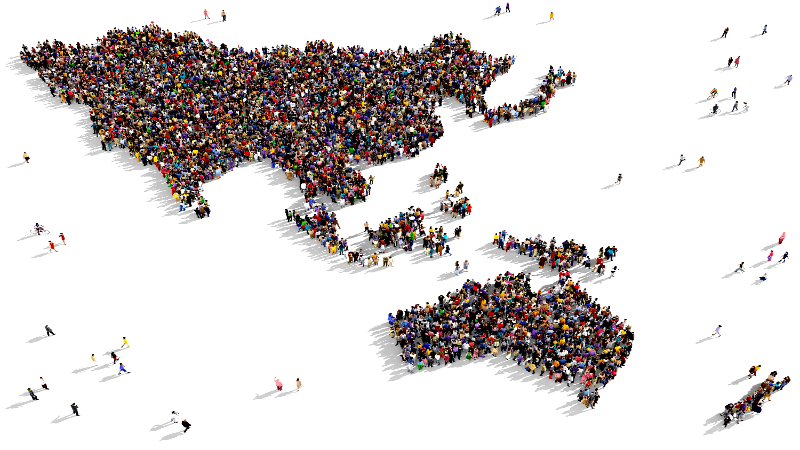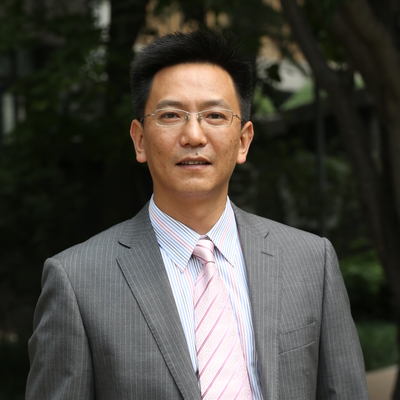Australia-China monthly wrap-up: March 2020 | Perspectives: What a virus teaches us about China-US relations
April 03 2020

This edition features:
- Summary and analysis of major developments in March 2020 by Elena Collinson and James Laurenceson.
- Perspectives: ‘What a virus teaches us about China-US relations’ by Professor Tao Xie. Perspectives is UTS:ACRI's monthly commentary series, featuring a piece on a topical subject in the Australia-China relationship from an invited expert contributor.
SUMMARY AND ANALYSIS OF MAJOR DEVELOPMENTS IN MARCH 2020
By Elena Collinson and James Laurenceson
As Australia battles COVID-19 on home ground the government has focused on staying a steady geopolitical course, even as its main security ally and main economic partner engage in antagonistic rhetorical sparring against the backdrop of the pandemic. Challenges with respect to Australia’s relationship with the PRC have been met firmly, but diplomatically.
On March 26 it was reported that at least two mainland Chinese property developers through January and February had sourced and shipped medical supplies in bulk from Australia to the People’s Republic of China (PRC). A report on April 2 confirmed a third company had also participated. Staff were diverted from their day-to-day responsibilities, instructed to participate in procurement efforts by any means available, including through retail outlet purchases. The companies were quick to point out that the activity had occurred while the COVID-19 crisis was at its peak in the PRC. The circumstances notwithstanding, one key takeaway from these activities is how swiftly mainland Chinese-owned companies overseas can be mobilised to support state efforts. It will now also be interesting to note whether the same companies, in consideration of their social license to operate, concentrate a similar effort into sending supplies the opposite direction. One property developer, Greenland Australia, has pledged to ‘[help] people in this country through a similar effort to that undertaken for China.’
On March 29 Treasurer Josh Frydenberg announced temporary changes to Australia’s foreign investment review framework, requiring approval for all proposed foreign investments into Australia ‘regardless of value or the nature of the foreign investor’, extending timeframes for reviewing applications from 30 days to up to six months. While the decision might have been precipitated by the mainland Chinese-owned companies procurement efforts, as suggested by The Australian Financial Review, the Treasurer opted to stay the diplomatic course by publicly, repeatedly maintaining that the measures were ‘not directed at a particular country’, noting that the US remained Australia’s number one investor by value. Foreign Investment Review Board chair David Irvine reiterated the point in a fashion, stating, ‘These temporary measures have been necessitated by extraordinary economic circumstances. Foreign investment is and will continue to be critical to Australia’s prosperity.’ This serves to emphatically highlight the restrained, signal-conscious approach Australia has adopted, as compared with the US, in terms of managing its relationship with the PRC at this time.
Amidst the turbulence of COVID-19, the PRC towards the end of March moved to indict Australian citizen, the author Yang Hengjun on charges of espionage, without providing Australia with any formal advice on his indictment. This elicited a strong response from Australian Foreign Minister Marise Payne who emphasised the Australian government’s objection to the indictment, and again asserted that Dr Yang’s treatment was ‘unacceptable’. While the PRC Foreign Ministry continues to claim that Dr Yang’s ‘legal rights are fully protected’, he continues to be held in harsh conditions with no access to legal representation, over a year on from the start of his detention. A Department of Foreign Affairs and Trade representative at Senate Estimates on March 5 noted the last time consular access to Dr Yang was permitted was December 30 2019.
News at the beginning of this month that the entire Foreign Influence Transparency Scheme (FITS) leadership had been replaced by Attorney-General Christian Porter indicated that refining Australia’s Foreign Influence Transparency Scheme (FITS) is a priority for the Australian government, following somewhat lacklustre participation on the register in the months after its rollout. There will reportedly be a new focus on influencing activities relating to critical infrastructure, foreign-owned media and foreign-funded institutions in universities. That influencing activities by the PRC in these contexts will be of particular interest might be evinced by the recruitment of China analyst John Garnaut ‘to help prepare evidentiary briefs against people suspected of being undeclared agents of influence.’[1]
On matters of defence, amongst developments of note this month: (1) some confirmation that, despite concerns about PRC and Russian intentions with respect to militarisation and mining in Antarctica, no evidence supporting movements towards such activities was found during the ‘most ambitious and far-reaching inspection tour’ ever conducted by Australia; and (2) on reports of a PRC vessel, the Xiang Yang Hong 01, allegedly mapping the west coast of Australia, the Chief of the Defence Force stated ‘We don’t have any concerns with the presence of that vessel in international waters’, with the Defence Secretary adding, ‘[A] vessel operating in international waters in accordance with international law is within its rights to do so. We have the right to monitor that.’
The total value of Australia’s good exports to the PRC continued to hold up in the year to January 2020. It fact at $150.4 billion it was a record high. But it all owes to mining, up 38.9 percent over the past year, compared with non-mining goods, which are down 2.2 percent. Data covering services in aggregate are published with a five-month lag, but the more timely monthly numbers covering commencing mainland Chinese students were down 5.2 percent in January.
The impact of COVID-19 is expected to magnify these divergences. In a new report, the Department of Industry, Science, Energy and Resources forecast that PRC economic activity would quickly rebound now that the number of new COVID-19 cases has dramatically slowed and that the majority of workplaces in the PRC would be fully operational by the end of June 2020. In turn, they concluded, ‘this still implies enormous commodity demand in absolute terms’. A return to normalcy in the PRC economy might also suggest some post-COVID-19 relief for Australia’s agricultural exporters like wine and beef in the second half of the year. But Australia is closer to the beginning than the end of managing the COVID-19 spread domestically, meaning measures to restrict mainland Chinese students and tourists (and those from all other countries) are still in place and will be for an extended period. In the year to September 2019, Chinese short-term visitors for education purposes injected $7.1 billion of expenditure into the Australian economy. This won’t be entirely wiped out as some Chinese students have been able to enter the country after spending a 14 quarantine period in a third country, and some will still be paying tuition fees while studying remotely. But the $3.2 billion from Chinese holiday-makers and the $1.2 billion visiting friends and relatives will take a massive hit.
Key trade indicators table - March 2020
Elena Collinson is a senior researcher at the Australia-China Relations Institute, the University of Technology Sydney.
Professor James Laurenceson is Director of the Australia-China Relations Institute at the University of Technology Sydney.
Sources
[1] Ellen Whinnett,’Secret agent blitz’, Herald-Sun, March 3 2020, p6.
PERSPECTIVES | WHAT A VIRUS TEACHES US ABOUT CHINA-US RELATIONS
By Tao Xie
Few residents of Wuhan, a city in central China, would ever imagine that their hometown would become an international household name overnight. But it did, and all because of a novel coronavirus, whose victims were first identified in the city in late December 2019. Named COVID-19 (coronavirus disease 2019) by the World Health Organization in early February, the virus has now become a global pandemic, forcing many governments to impose domestic and international travel bans and bringing the global economy to a grinding halt.
A virus is colour blind, to invoke former US Supreme Court Justice John Marshall Harlan. It does not discriminate on the basis of race, religion, or socioeconomic status. It has no ideological bias. It recognises no national boundary.
Thus in the face of a pandemic that has quickly gone global, one would expect the People’s Republic of China (PRC) and the US – the two biggest players in global governance – to work together against it. Yet unfortunately, for nearly two weeks the two governments chose instead to embroil themselves in a war of words over the most appropriate name for the deadly virus, and who ought to shoulder the blame over its outbreak. Then, just as most analysts were gearing up for escalating tensions, Beijing and Washington suddenly decided at the March 26 G20 virtual summit to stop finger-pointing – at least for the moment – and behave instead as responsible stakeholders in the global fight against COVID-19.
The year 2020 began somewhat promisingly for China-US relations, as the two governments on January 15 signed a preliminary agreement that eased the 18-month-long bilateral trade war. The outbreak of COVID-19 was initially hailed as an opportunity for them to enhance joint efforts to deal with non-conventional security threats. As late as March 1, the Chinese embassy in Washington declared on its website that it had spared no effort in promoting China-US cooperation to fight against the virus.
But against the backdrop of geopolitical rivalry, economic competition, and emerging ideological confrontation between the world’s two most powerful countries, one should hardly be surprised that COVID-19 has become a bone of political contention and a source of outlandish conspiracy theories.
In fact, COVID-19 is merely a new genie in the old bottle of China-US mutual distrust. The genie is not the cause of mutual distrust, but its politicisation is certainly an effect of that distrust. There will undoubtedly be more new genies, and the old bottle may soon explode, unless both Beijing and Washington immediately rethink their assumptions and beliefs about the other and about themselves, and readjust their respective policies accordingly.
More specifically, there are not-so-small number of elites and members of the public in both countries who view the other through the lens of paranoia. And through social media, think tank reports, podcasts, and policy papers, these views can spread as quickly as COVID-19. On the American side, China is portrayed as actively undermining the US-led liberal international order, challenging America’s global leadership, and launching a massive disinformation campaign – dubbed China’s ‘sharp power’ strategy – to sway American public opinion. On the Chinese side, the US is depicted as bent on preventing China from realising its great rejuvenation and obsessed with destabilising China’s political order. As a result, anything that goes wrong at home or abroad in one country is often reflexively attributed to the sinister and deliberate plan of the other.
Pundits have offered many suggestions on increasing trust between Beijing and Washington, including economic interdependence, people-to-people exchanges, and frequent high-level dialogues. But so far the effects of these measures seem marginal. Even when both are threatened by a serious non-conventional global threat like COVID-19, they apparently have failed to work together, up until now.
It is politically convenient to single out the Trump presidency as the biggest factor behind the current state of China-U.S. relations. To be sure, Trump has accelerated the destabilisation of the bilateral relationship with, for example, the trade war), but there were already signs of increasing distrust during Obama’s second term, such as the strong US opposition to the Asian Infrastructure Investment Bank. So a post-Trump era in 2021 or 2025 will not necessarily indicate a reversion to the ‘old normal’. There is something structural going on, but structural forces are almost always beyond the control of one country.
So what can help reduce mutual distrust between Beijing and Washington? As an old Chinese saying goes, the solution to a crisis usually lies in the crisis itself. Perhaps COVID-19 can be a unique opportunity for China and the US to mend their relations. After all, Americans desperately need face masks and other personal protective equipment, of which China is currently the world’s major producer. And while there were reportedly some missteps in the beginning, China’s experiences in effectively controlling the spread of the virus within its border can be invaluable to America’s struggle right now. And, equally, it is in China’s best interests if the US economy quickly recovers, as it critically depends on America’s market, technology and services. But this asymmetrical dependence may be perceived as a serious national security threat – some US politicians have already voiced such concerns, and it is entirely possible that the post-COVID-19 era will witness a faster decoupling of the world’s two largest economies.
But let us hold out hope that the deadly virus will become a uniter – rather a divider – in bilateral relations, bringing about a decrease – even if small and temporary – in mutual distrust. The biggest lesson to be learned by leaders in both countries is perhaps that political distrust is a far more dangerous virus than COVID-19 or its variants, and with this lesson in mind, we will be close to seeing a new page turned in China-US relations.
Professor Tao Xie is an Adjunct Professor at the Australia-China Relations Institute, University of Technology Sydney.
Professor Tao Xie is the Dean of the School of International Relations and Diplomacy, Beijing Foreign Studies University. He holds a PhD in political science from Northwestern University. Professor Xie’s research interests include American politics, China-U.S. relations, and Chinese foreign policy. He has published extensively in both English and Chinese, including most recently 'In the Shadow of Strategic Rivalry: China, America, and the Asian Infrastructure Investment Bank', published in the Journal of Contemporary China.
Authors
|
Professor James Laurenceson Director 
|
|---|
|
Elena Collinson Manager, Research Analysis 
|
|---|
|
Professor Tao Xie Adjunct Professor, UTS:ACRI 
|
|---|
